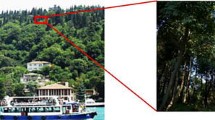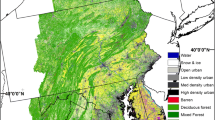Abstract
The application of landscape patch shape complexity as a predictor ofvascularplant and bryophyte species richness is analysed. Several common complexityindices (shape index, fractal dimension, comparison to the area of the minimumbounding rectangle) are tested for their predictive power for plant speciesrichness. One new robust measure for shape complexity is presented whichovercomes some disadvantages of common complexity measures applied to highresolution analysis of agricultural landscapes based on aerial photographs. Thenew index is based on the number of shape characterising points along apolygon’s boundary. This new measure shows promising predictive capabilitiesforspecies richness of vascular plants and bryophytes (correlation coefficient:0.85 for vascular plants, 0.74 for bryophytes).
Similar content being viewed by others
References
Abensperg-Traun M., Arnold G.W., Steven D.E., Smith G.T., Atkins L., Viveen J.J. et al. 1996. Biodiversity indicators in semiarid, agricultural Western Australia. Pacific Conservation Biology 2: 375–389.
Andersen A.N. 1995. Measuring more of biodiversity: genus richness as a surrogate for species richness in Australian ant faunas. Biological Conservation 73: 39–43.
Alard D. and Poudevigne I. 1999. Factors controlling plant diversity in a rural landscape: a functional approach. Landscape and Urban Planning 46: 29–39.
Andersen A.N. 1995. Measuring more of biodiversity: genus richness as a surrogate for species richness in Australian ant faunas. Biological Conservation 73: 39–43.
Austin M.P., Pausas J.G. and Nichols A.O. 1996. Patterns of tree species richness in relation to environment in south-eastern New South Wales, Australia. Australian Journal of Ecology 21: 154–164.
Balmford A., Jayasuriya A.H.M. and Green M.J.B. 1996. Using higher-taxon richness as a surrogate for species richness: II. Local applications. Proc. Royal Soc. London Serie B 263: 1871–1875.
Currie D.J. 1991. Energy and large-scale patterns of animal-and plant-species richness. The American Naturalist 137: 27–49.
Douglas D.H. and Peuker T.K. 1973. Algorithms for reduction of the number of points required to represent a digitized line or it’s character. The Canadian Cartographer 10: 112–123.
Dramstad W.E., Fjellstad W.J. and Fry G.L.A. 1998. Landscape indices-useful tools or misleading numbers? In: Dover J.W. and Bunce R.G.H. (eds), Key concepts in landscape ecology. Proceedings of the 1998 European Congress of the International Association for Landscape Ecology, held at the Myerscough College 3rd-5th September 1998. JALE, UK, pp. 36–73.
Duelli P. 1997. Biodiversity evaluation in agricultural landscapes: An approch at two different scales. Agriculture Ecosystems and Environment 62: 81–91.
Faith D.P. and Walker P.A. 1996. Environmental diversity: on the best-possible use of surrogate data for assessing the relative biodiversity of sets of areas. Biodiversity and Conservation 5: 399–415.
Findlay C.S. and Houlahan J. 1997. Anthropogenic correlates of species richness in southeastern Ontario wetlands. Conservation Biology 11: 1000–1009.
Forman R.T.T. and Moore P.N. 1992. Theoretical Foundations for Understanding Boundaries in Landscape Mosaics. In: Hansen A.J. and Castri F. (eds), Landscape Boundaries: Consequences for Biotic Diversity and Ecological Flows. Springer-Verlag, New York, New York, USA, pp. 236–258.
Forman R.T.T. 1995. Land Mosaics: The Ecology of Landscapes and Regions. Cambridge University Press, Cambridge, UK.
Forman R.T.T. 1999. Horizontal Processes, Roads, Suburbs, Societal Objectives, and Landscape Ecology. In: Klopatek J.M. and Gardner R.H. (eds), Landscape Ecological Analysis: Issues and Applications. Springer-Verlag, New York, New York, USA, pp. 35–53.
Gaston K.J. 2000. Biodiversity: higher taxon richness. Progress in Physical Geography 24: 117–127.
Gierloff-Emden H.G. 1989. Fernerkundungskartographie mit Satellitenaufnahmen-Allgemeine Grundlagen und Anwendungen. Enzyklopädie der Kartographie Band IV/1. Franz Deuticke, Wien.
Griffiths G.H., Lee J. and Eversham B.C. 2000. Landscape pattern and species richness; regional scale analysis from remote sensing. International Journal of Remote Sensing 21: 2685–2704.
Haines-Young R. and Copping M. 1996. Quantifying landscape structure: a review of landscape indices and their application to forested landscapes. Progress in Physical Geography 20: 418–445.
Heikkinen R.K. and Neuvonen S. 1997. Species richness of vascular plants in the subarctic landscape of northern Finland: modelling relationships to environment. Biodiversity and Conservation 6: 1181–1201.
Hietala-Koivu R. 1999. Agricultural landscape change: a case study in Yläne, southwest Finland. Landscape and Urban Planing 46: 103–108.
Hoover S.R. and Parker A.J. 1991. Spatial components of biotic diversity in landscapes of Georgia, USA. Landscape Ecology 5: 125–136.
Howard P.C., Viskanic P., Davenport T.R.B., Kigenyi F.W., Baltzer M., Dickinson C.J. et al. 1998. Complementarity and the use of indicator groups for reserve selection in Uganda. Nature 394: 472–475.
Hulshoff R.M. 1995. Landscape indices describing a Dutch landscape. Landscape Ecology 10: 101–111.
Iverson L.R. 1988. Land use change in Illinois, USA: The influence of landscape attributes on current and historic land use. Landscape Ecology 2: 45–61.
Kammerbauer J. and Ardon C. 1999. Land use dynamics and landscape change pattern in a typical watershed in the hillside region of central Honduras. Agriculture Ecosystems & Environment 75: 93–100.
Krummel J.R., Gardner R.H., Sugihara G., O’Neill R.V. and Coleman P.R. 1987. Landscape patterns in a disturbed environment. Oikos 48: 321–324.
Lawton H.P., Bignell D.E., Bolton B., Bloemers G.F., Eggleton P., Hammond P.M. et al. 1998. Biodiversity inventories, indicator taxa and effects of habitat modification in tropical forests. Nature 391: 72–76.
Linder H.P. 1991. Environmental correlates of patterns of species richness in the south-western Cape province of South Africa. Journal of Biogeography 19: 509–518.
Loibl W. and Züger J. 2001. FTSP-Programm “Komplexitität und Nachhaltigkeit” Teilprojekt 2: Kleinräumige Modellierung von Klimaparametern. Seibersdorf Research Report OEFZS-S-0124, BV, April 2001.
Luoto M. 2000. Modelling of rare plant species richness by landscape variables in an agricultural area in Finland. Plant Ecology 149: 157–168.
Mandelbrot B. 1983. The Fractal Geometry of Nature. W.H. Freeman and Company, New York, New York, USA.
Mander Ñ., Mikk M. and Külvik M. 1999. Ecological and low intensity agriculture as contributors to landscape and biological diversity. Landscape and Urban Planning 46: 169–177.
McGarigal K. and Marks B.J. 1995. FRAGSTATS: spatial pattern analysis program for quantifying landscape structure. US Forest Service General Technical Report PNV 351.
Margules C.R., Nicholls A.O. and Austin M.P. 1987. Diversity of Eucalyptus species predicted by a multi-variable environmental gradient. Oecologia 71: 229–232.
Miller J.N., Brooks R.P. and Croonquist M.J. 1997. Effects of landscape patterns on biotic communities. Landscape Ecology 12: 137–153.
Milne B.T. 1990. Lessons from Applying Fractal Models to Landscape Patterns. In: Turner M.G. and Gardner R.H. (eds), Quantitative Methods in Landscape Ecology: Analysis and Interpretation of Landscape Heterogeneity. Springer-Verlag, New York, New York, USA, pp. 99–235.
Nichols W.F., Killingbeck K.T. and August P.V. 1998. The Influence of Geomorphological Heterogeneity on Biodiversity II. A landscape Perspective. Conservation Biology 12: 371–379.
Novàkovà J. 1997. Agricultural impact on nonlinear vegetation formations: species richness-stand trophy relations. Ekològia 16: 233–241.
O’Brian E.M. 1998. Water-energy dynamics, climate, and prediction of woody plant species richness: an interim general model. Journal of Biogeography 25: 379–398.
O’Neill R.V., Hunsaker C.T., Timmins S.P., Jackson B.L., Jones K.B., Riitters K.H. et al. 1996. Scale problems in reporting landscape pattern at the regional scale. Landscape Ecology 11: 169–180.
O’Neill R.V., Krummel J.R., Gardner R.H., Sugihara G., Jackson B., DeAngelis D.L. et al. 1988. Indices of landscape pattern. Landscape Ecology 1: 153–162.
Odum E.P. and Turner M.G. 1989. Georgia Landscape: A Changing Resource. In: Zonneveld I.S. and Forman R.T.T. (eds), Changing Landscapes: An Ecological Perspective. Springer-Verlag, New York, New York, USA, pp. 137–146.
Palmer M.W. 1995. How Should One Count Species? Natural Areas Journal 15: 124–135.
Pearson D.L. and Cassola F. 1992. World-wide species richness patterns of tiger beetles (Coleoptera: Cicindelidae): indicator taxon for biodiversity and conservation studies. Conservation Biology 6: 376–391.
Prendergast N., Quinn R.M., Lawton J.H., Eversham B.C. and Gibbons D.W. 1993. Rare species, the coincidence of diversity hotspots and conservation strategies. Nature 365: 335–337.
Rathert D., White D., Sifneos J.C. and Hughes R.M. 1999. Environmental correlates of species richness for native freshwater fish in Oregon, USA. Journal of Biogeography 26: 257–273.
Rex K.D. and Malanson G.P. 1990. The fractal shape of riparian forest patches. Landscape Ecology 4: 249–258.
Richerson P.J. and Lum K. 1980. Patterns of plant species diversity in California: relation to weather and topography. The American Naturalist 116: 504–536.
Riitters K.H., O’Neill R.V., Hunsaker C.T., Wickham J.D., Yankee D.H., Timmins S.P. et al. 1995. A factor analysis of landscape pattern and structure metrics. Landscape Ecology 10: 23–39.
Steinhauser F. 1972. Niederschlagskarte von Österreich für das Normaljahr 1901–1950. Maßstab 1:500.000. Hydrographisches Zentralbüro im BM für Land-und Forstwirtschaft, Wien.
Turner M.G. and Ruscher C.L. 1988. Changes in the spatial patterns of land use in Georgia. Landscape Ecology 1: 241–251.
Turner M.G. 1990. Spatial and temporal analysis of landscape patterns. Landscape Ecology 4: 21–30.
Virolainen K.M., Ahlroth P., Hyvärinen E., Korkeamäki E., Mattila J., Päivinen J. et al. 2000. Hot spots, indicator taxa, complementarity and optimal networks of taiga. Proc. Royal Soc. London Serie B 267: 1143–1147.
Wohlgemuth T. 1998. Modelling floristic species richness on a regionsl scale: a case study in Switzerland. Biodiversity and Conservation 7: 159–177.
Zechmeister H.G. and Moser D. 2001. The influence of agricultural land-use intensity on bryophyte species richness. Biodiversity and Conservation 10: 1609–1625.
Author information
Authors and Affiliations
Rights and permissions
About this article
Cite this article
Moser, D., Zechmeister, H.G., Plutzar, C. et al. Landscape patch shape complexity as an effective measure for plant species richness in rural landscapes. Landscape Ecol 17, 657–669 (2002). https://doi.org/10.1023/A:1021513729205
Issue Date:
DOI: https://doi.org/10.1023/A:1021513729205




